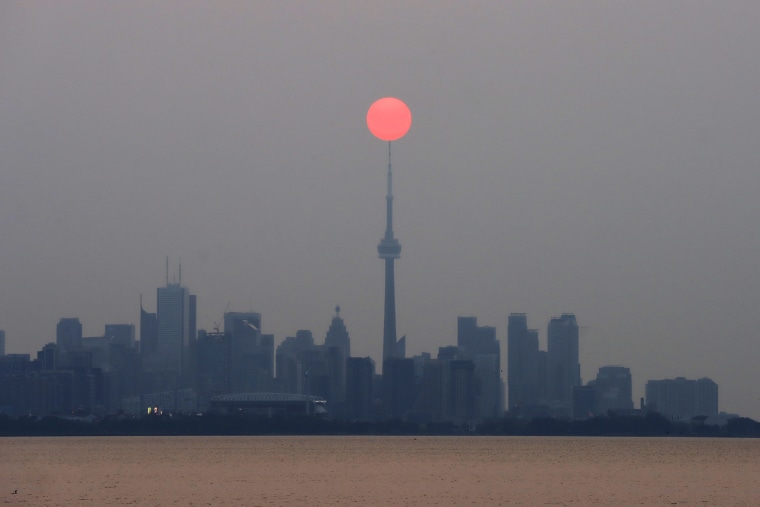Western wildfire smoke creates fiery sunrise 2,000 miles away in New York City
By Jeremy Lewan and Kathryn Prociv July 20, 2021

The sun rises above the CN Tower through a thick haze caused by smoke from forest fires burning in western Canada moving through the upper atmosphere July 19, 2021, in Toronto.Gary Hershorn / Getty Images
After baking in weeks of searing heat, the West is erupting in fierce wildfires so strong the smoke was visible Tuesday on the East Coast in cities such as New York and Washington, D.C.
Air quality alerts were issued for New York City on Tuesday, and the National Weather Service urged sensitive groups to remain indoors.
More than 75 wildfires have already scorched more than 1 million acres in 13 states. On Tuesday, 3 million people remained under red flag warnings blanketing eight states across the Northwest and the northern Plains, including the area of the Bootleg Fire in Oregon, currently the largest fire this year.
Large wildfire scorches Oregon
JULY 16, 2021
Now classified as a megafire,or a fire burning more than 100,000 acres, the Bootleg Fire has blazed over 350,000 acres, which is about half the size of Rhode Island, and was only 30 percent contained as of Tuesday.
Conditions surrounding the area have exhibited extreme fire behavior, and the massive inferno has been so powerful that it created its own weather, generating dangerous columns of lightning-charged smoke and ash, called pyrocumulus or pyrocumulonimbus clouds, reaching the stratosphere. These can reach more than 40,000 feet into the atmosphere – the altitude at which commercial airplanes fly.
The Beckwourth Complex Fire, raging in Northern California, has topped 100,000 acres burned, also earning the megafire title. With more than 1,000 firefighters working, the fire was nearly 90 percent contained Tuesday.
Pacific Gas and Electric, California’s largest utility, may be responsible for another blaze licking across Northern California. On Sunday, a spokesperson admitted that blown fuses on one of its utility poles may have sparked the over the Dixie Fire, which is 30,000 acres and growing. This comes after PG&E has taken responsibility for the devastating 2018 Camp Fire and the 2019 Kincade Fire that burned more than 100 square miles of Sonoma County.
According to an update Monday from the California Department of Forestry and Fire Protection, or CAL FIRE, compared to this same time last year, there are over 900 more fires and 165,000 additional acres burned. For context, 2020 was the worst Western fire season in history.
The situation has become so dire that the National Interagency Fire Center has upgraded the national preparedness level to the highest category, Level 5, signifying that at least 80 percent of wildland firefighters are currently responding to fires.
Wildfire growth and spread are expected to intensify through the week as yet another major heat wave roasted the high Plains and the Rocky Mountains, peaking Monday. Triple-digit temperatures, combined with humidity as low as 10 percent and wind gusts up to 40 mph, will produce ideal wildfire conditions. An additional major concern is the dry thunderstorms expected to flare along the interior Northwest, producing abundant lightning that could easily spark sun-baked vegetation.
Climate scientists are certain that temperatures this extreme would have been “virtually impossible without climate change.“

